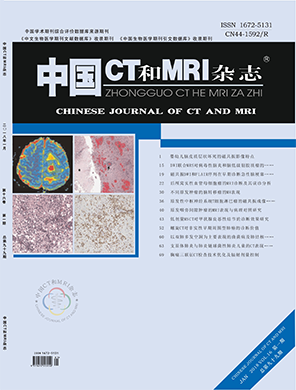摘要
目的 探讨我国对于特定人群的 乳腺早期筛查,优先选择X线钼靶还是选 择乳腺MRI检查更有应用价值。方法 回 顾性分析2013年7月至2015年8月在我院 门诊或住院同时接受乳腺X线钼靶检查 及MRI检查患者,其中符合条件的47例 为研究对象,入组条件为年龄≤60岁, 乳腺组织为致密型或多腺体型,以病理 或追踪复查作为金标准,比较选择乳腺 钼靶X线或磁共振成像检查对特定人群的 乳腺疾病的早期筛查的准确率。结果 47 例患者中, 乳腺X线检查准确率是72%, 乳腺MRI检查准确率83%。乳腺X线钼靶与 乳腺MRI检查的结果不相同,差异有统计 学意义(P<0.05)。此外,乳腺X线钼靶和 乳腺MRI的灵敏度是一致的,这两个都为 90%,而MRI的特异性(71%)明显高于X线 钼靶(41%)。结论 由于MRI对软组织的分 辨力高且无辐射,对于发现乳腺病变具 有更高的敏感性,对于满足人群的特定 条件的患者,选择乳腺MRI检查作为早期 筛查或追踪复查的手段具有更高的应用 价值。
Objective To explore the specific screening of breast cancer, which is chose the prority of X-ray mammography or breast MRI is more valuable. Methods Retrospective analysis about our hospital outpatients or inpatients who accept breast mammography and MRI examination at the same time form July 2013 to August 2015. Eligible for the study were 47 cases, the conditions for the age of ≤60 age, mammary gland tissue for the dense or polyglandular type, with pathology or follow-up review as the gold standard, compared to the selection of breast mammography or MRI of specific populations of mammary gland disease in the early screening accuracy. Results The accuracy rate of mammography was 72%, and the accuracy rate of MRI was 83% in 47 cases. The results of breast mammography or MRI were different, and the difference was statistically significant(P<0.05). In addition, it can find that the sensitivity of X-ray and MRI is consistent, both of which were 90%, while MRI specificity 71% was significantly higher the X-ray mammography (41%). Conclusion Because the MRI has high resolution of soft tissue and no radiation, it's more sensitive to the discovery of breast lesions. For patients who meet the specific conditions of the population, the choice of breast MRI as higher as a means of early screening or follow-up review the value.
【关键词】特定人群;乳腺疾病;早期 筛查;钼靶;磁共振成像
【中图分类号】R445.2;R739.9
【文献标识码】A
【DOI】 10.3969/j.issn.1672- 5131.2018.01.027
前言
在我国,乳腺癌发病率位居大城市女性肿瘤的第一位。在无症状 女性人群中,各种乳腺疾病患者竟达到52.4%,此发病数大大高于女性 其他慢性常见病而占首位。其中仅患乳腺增生的妇女数高达49.7%。 中国抗癌协会公布的统计数字显示,我国近年来乳癌发病率正以每年 3%的速度递增,成为城市中死亡率增长最快的癌症,发病年龄也呈逐 渐年轻化的趋势。中国主要城市10年来乳腺癌发病率增长了37%,死 亡率增长了38.9%,农村死亡率增长了39.7%。相关资料分析发现,西 方妇女乳腺癌的发病人数高峰年龄为50~55岁,但中国女性的乳腺癌 发病年龄的高峰期要比西方女性小10岁左右。而且我国女性乳腺多属 于致密型或多腺体型,在一定程度上影响了乳腺X线钼靶检查的敏感 性和诊断性。对于乳腺癌的早期筛查与诊断,是必须依靠影像学检查 手段,而且乳腺MRI能检出乳腺X线钼靶摄影(mammography,MG)、超声 (ultrasound,US)及体查等手段没法检出的小乳腺癌和早期乳腺癌[1]。 美国癌症协会将MRI作为乳腺癌普查时MG的补充,高危人群每年可直接 接受乳腺癌MRI检查[2]。虽然目前依然首推乳腺X线钼靶作为早期筛查 和诊断乳腺癌的影像学诊断工具,但是乳腺X线钼靶在没有钙化和不发 生浸润的DCIS病灶的诊断中仍具有一定的局限性,对此病例,我们需 要更重视乳腺MRI的诊断结果。
中国CT和MRI杂志
第16卷, 第 1 期
2018年01月

相关文章